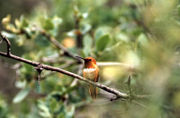The Rufous Hummingbird (Selasphorus rufus) is a small hummingbird, about 10 cm long with a long, straight and very slender bill. The female is slightly larger than the male.
The adult male, shown in the photo, has a white breast, rufous face, upperparts, flanks and tail and aniridescent orange-red throat patch (gorget). Some males have some green on back and/or crown. The female has green upperparts, white underparts, some iridescent orange feathers in the center of the throat, and a dark tail with white tips and rufous base. Females and the rare green-backed males are extremely difficult to differentiate from Allen’s Hummingbird.
Their breeding habitat is open areas and forest edges in western North America from southern Alaska toCalifornia. This bird nests further north than any other hummingbird. The female builds a nest in a protected location in a shrub or conifer. The male aggressively defends feeding locations within his territory. The same male may mate with several females.

Public Domain image
They are migratory, many of them migrating through the Rocky Mountains and nearby lowlands in July and August to take advantage of the wildflower season there. They may stay in one spot for considerable time, in which case the migrants, like breeding birds, often aggressively take over and defend feeding locations. Most winter in wooded areas in the Mexico state of Guerrero, traveling over 2,000 miles by an overland route from its nearest summer home–a prodigious journey for a bird weighing only three or four grams.
This is the western hummingbird most likely to stray into eastern North America. There has been an increasing trend for them to migrate east to winter in the eastern United States, rather than south to Central America. This trend is the result of increased survival with the provision of artificial feeders in gardens. In the past, individuals that migrated east in error would usually die, but now they often survive, and their tendency to migrate east is inherited by their offspring. Provided sufficient food and shelter is available, they are surprisingly hardy, able to tolerate temperatures down to at least -20°C.

These birds feed on nectar from flowers using a long extendable tongue or catch insects on the wing.
Because of their small size, they are vulnerable to insect-eating birds and animals. These birds require frequent feeding while active during the day and become torpid at night to conserve energy.
References
 BirdLife International (2004). Selasphorus rufus. 2006 IUCN Red List of Threatened Species. IUCN 2006. Retrieved on 09 May 2006. Database entry includes justification for why this species is of least concern
BirdLife International (2004). Selasphorus rufus. 2006 IUCN Red List of Threatened Species. IUCN 2006. Retrieved on 09 May 2006. Database entry includes justification for why this species is of least concern
External links
 http://www.hummingbirdsociety.org/photogallery – photographs of this and other hummingbird species
http://www.hummingbirdsociety.org/photogallery – photographs of this and other hummingbird species
Retrieved from “http://en.wikipedia.org/wiki/Rufous_Hummingbird”
All text is available under the terms of the GNU Free Documentation License.
Wikipedia® is a registered trademark of the Wikimedia Foundation, Inc.

